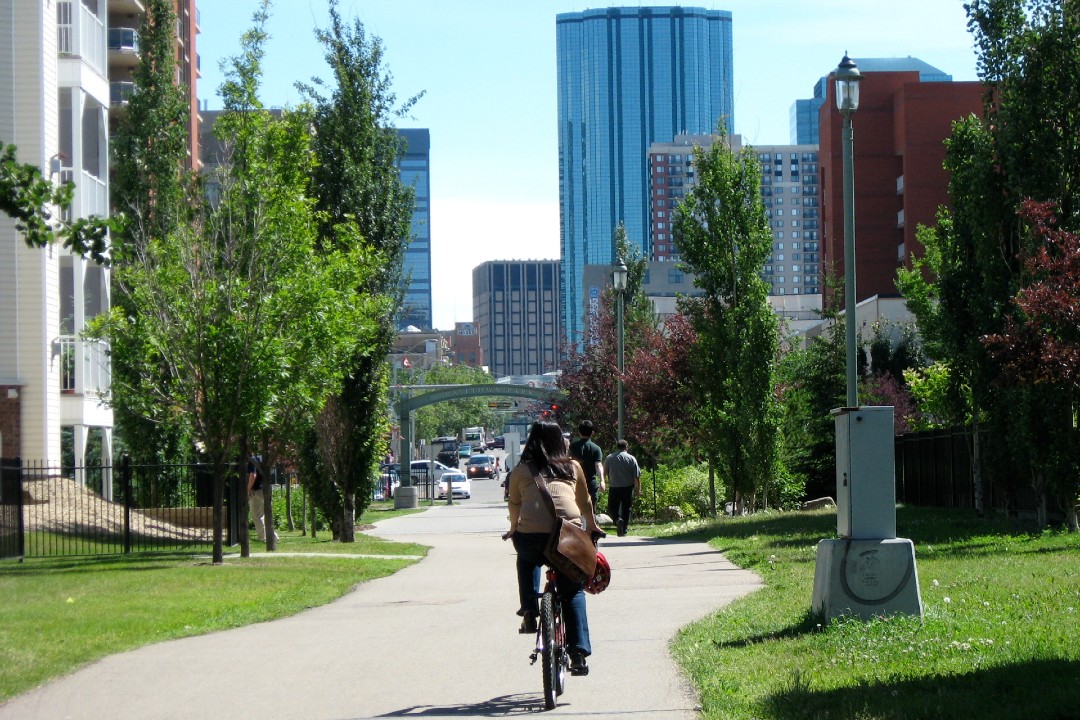Taproot's listening work with voters in the lead up to the 2025 municipal election in October reveals that many see active transportation infrastructure as an election issue.
At least 150 respondents told Taproot that active transportation infrastructure, like bike lanes and multi-use pathways, is a top election issue. While some said they were against bike lanes, most said they support adding and maintaining safe active transportation options. Some wanted infrastructure to feature better design and connections to other areas. Many suggested active transportation is interconnected with other city concerns, like transit, infill housing, and sprawl. Several specifically said they were concerned that the provincial government would interfere with the city's decisions on bike lanes. Others said they want to see data that proves that bike lanes are needed.
Earlier this year, we launched our listening campaign at several in-person and virtual events, as well as a 2025 election question on our site. We have been gathering responses ever since, and at last count, more than 800 people have provided them. The listening was built around a simple question: "What issues do you care about as you consider who to vote for in the 2025 municipal election, and why?"
One person told Taproot they were looking for a candidate who supports active transportation. "Utilitarian cycling in Edmonton is getting better all the time and we should keep building that capacity. Edmonton drivers are feeling the squeeze as roads get more congested, especially in densifying neighbourhoods like Ritchie," they said. "Multi-modal transport is the future! Communauto car share, cycling, transit, scooters, everything is needed to reduce personal car trips."
Another said they wanted to examine the voting record of incumbents on active transportation. "Which candidates are supportive of expanding bike lanes? Protected bike lanes? Which candidates have campaigned against or disparaged active transportation infrastructure in the past? Which candidates use public or active transportation themselves? Occasionally, or as a regular part of their daily activities?"
Still another emphasized they wanted high-quality bike infrastructure. "I would love to see bike lanes that don't just end, leaving cyclists on busy roads," they said.
A handful of respondents said they doubted whether the city's investments correlate to the number of people using active transportation infrastructure.
"I do not want taxpayer dollars wasted on pet projects," one said. "I want an accountability of the usage of the $100 million debt funding for the bike lanes. I want statistics to show the actual ridership numbers, and whether the program needs to be adjusted and by how much."
Beyond listening to voters, Taproot has worked to explain some of the intricacies of active transportation as we approach the 2025 election.

Much of the new active transportation infrastructure coming to Edmonton will be shared-use paths like the one pictured. These paths stretch three metres wide and are designed to be used by cyclists, pedestrians, and other users. (City of Edmonton)
A $100M investment
In December 2022, city council received significant attention when it approved an investment of $100 million over three years in the 2022-2026 budget to expand the city's active transportation network. In 2024, the city installed 10 routes spanning 17 kilometres. Most of the new infrastructure is focused on Edmonton's north side. In 2025, crews will construct approximately 23 kilometres of bike lanes across 23 routes. Again, much of that infrastructure will be built on the city's north side. Design work is underway for routes that will be built in 2026, the expansion's final year. The city plans to build 31 kilometres over 17 routes in 2026.
While mobility advocates have celebrated the new infrastructure, some have also criticized its design for not being safe or inviting for cyclists of all ages and abilities. Many of the new routes will be shared-use paths, which are three-metre-wide paths that are shared with pedestrians; others will be bikeways, which are painted lines on streets where cyclists share the road with vehicles and there are traffic-calming measures intended to slow drivers. Many cycling advocates describe bikeways, also known as "sharrows," as unsafe and not likely to encourage cycling. The city said it decides what type of infrastructure is need based on the characteristics of the street, including speed and traffic volumes.
The network expansion isn't the only mechanism council can use to increase the amount of bike infrastructure in Edmonton. In June, council reviewed the new proposed Complete Streets policy that would require collector roads to have a shared-use pathway on one side. The city will also consider adding new bike lanes in areas like Wîhkwêntôwin when these areas receive scheduled neighbourhood renewal.
Provincial involvement
In April, Alberta Transportation Minister Devin Dreeshen, who's the MLA for Innisfail-Sylvan Lake, visited Edmonton to discuss the 132 Avenue NW renewal project. That project will turn the four-lane road into a narrower collector that features bike lanes and wider sidewalks. The project has been under construction for more than two years, and a portion of the new lanes have already been installed. Dreeshen said he's opposed to projects that take away driving lanes and that Alberta could follow Ontario in requiring provincial approval for such projects.
How Taproot has approached this work
Taproot's election project is based on The Citizens Agenda, a way for newsrooms to make elections about more than just the horse race by listening intently to what voters say is important and shaping election coverage accordingly. We employed this approach in the leadup to the 2021 election as well.
